|
|
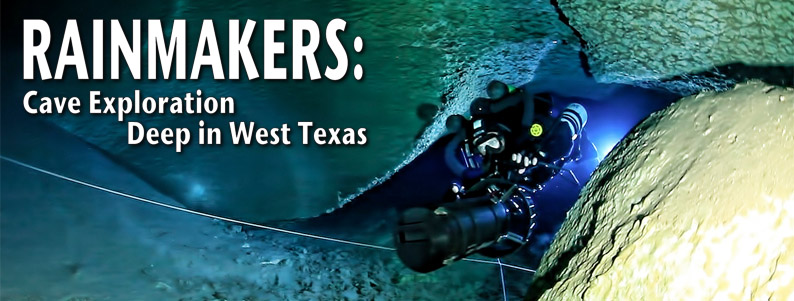 |
Text by Walter Pickel and Tom Iliffe
Photography by Curt Bowen & Walter Pickel |
| |
When cave exploration is discussed in the realm of United States cave diving, little is said of places other than Florida. There are spectacular caves in the Ozarks of Missouri, new caves being explored in Utah and numerous other states. Seldom is heard someone mentioning Texas, save Goodenough Springs and Jacob’s Well. Truth be told Texas has some amazing caves!
In January of 2012, Dr. Tom Iliffe of Texas A&M University at Galveston invited the ADM Exploration Team to join him as part of an investigation of West Texas caves and springs. Dr. Iliffe’s research was funded by a cooperative science grant between Texas A&M and CONACyT, the Mexican national science foundation, and aimed at the collection of rare cave adapted species from Phantom Springs Cave and ecological investigations of this fragile habitat. Primary scientific goals of the expedition were to explore and map the upstream and downstream sections of the cave so as to characterize the habitat, conduct comprehensive photo and video documentation, use radio locators to pinpoint significant biological features, and record the distribution of species within the cave. In order to carry out this work, a team of expert cave divers and diving scientists were assembled. A more perfect combination could not have been made! The expedition team consisted of Curt Bowen and Walter Pickel from the ADM Exploration Team, Brett Hemphill and Dr. Andy Pitkin from Karst Underwater Research and Dr. Tom Iliffe, Sepp Haukebo and David Brankovits from Texas A&M University at Galveston.
|
|
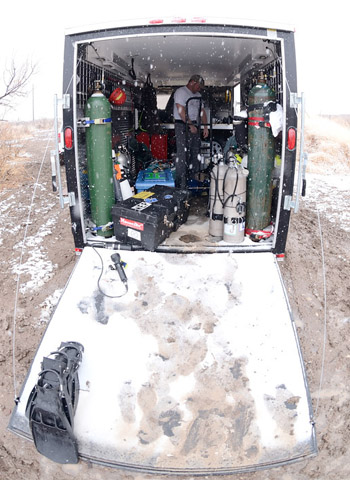 |
| Above: No precipitation for over 17 months, until the morning we arrive on the expedition. Snow flurries quickly turn into ice, then rain, then thick sticky mud.
Below: The ADM Exploration Team dive trailer and H2 set in a whiteout of snow on our first day of exploration. |
|
|
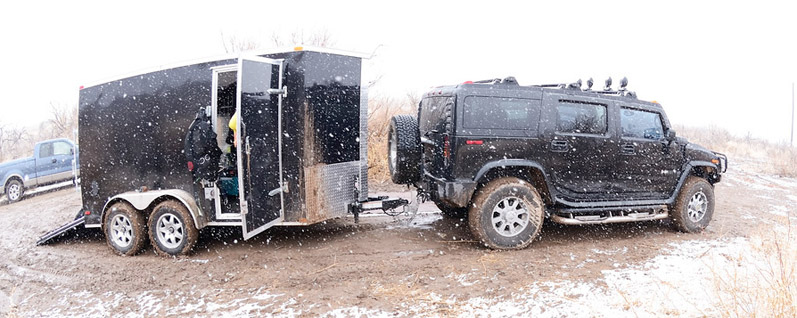 |
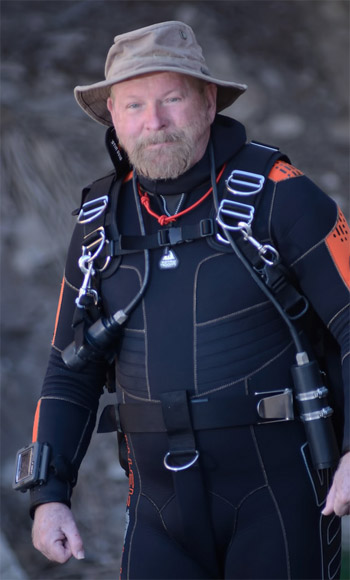 |
| Texas A&M professor, Dr. Thomas Iliffe prepares for a scientific dive into Phantom Cave. His main research includes the study of cave adapted organisms. |
|
Located near Toyahvale, Texas, Phantom Spring Cave is owned by the Federal Bureau of Reclamation and is host to the endangered Comanche Springs Pupfish and Pecos Gambusia. Access to the cave is tightly restricted and requires a special scientific permit. No other access to the cave or the surrounding property is allowed under any circumstances. Only two permits are issued at a time with both taken for at least the next two years. This is due to concerns of overuse of the fragile ecosystem of the pupfish which can be damaged to the extent of critically harming the fish if extreme care is not taken. Bill Tucker and his wife Franci are some of the original explorers of Phantom Springs Cave and hold an active permit for research diving and maintaining of the electrical systems, water pumps and grounds for the pupfish ecosystem. Bill and Franci joined us for part of the expedition and imparted 30 years of their invaluable historical knowledge of the cave.
Phantom Springs Cave is especially interesting in its geology. Most notable are the differing phreatic, joint controlled passages that have a meandering nature to them, undulating deeper and deeper as you dive further into the cave. Much of the first 3,000 feet of the upstream passage has dry domes above the water. Some of these dry areas are fissures that rise over one hundred feet, while others are mere nose pockets. Almost unbelievable was the discovery of cave coral speleothems that were discovered in one of the air filled ceiling domes. These are the first such secondary cave minerals to be found in Phantom Springs Cave. The cave continued to reveal her secrets and beauty to the team as throughout several sections of the upstream passage, chert nodules, many with a coating of black goethite, protruded from the cave walls like antlers from a herd of hundreds of deer. While diving through the clear blue waters of Phantom Springs Cave, a diver experiences the contrast of dark chert against the backdrop of the bone white limestone walls; I found myself mesmerized. Never before have I seen something quite as beautiful and intriguing.
|
|
|
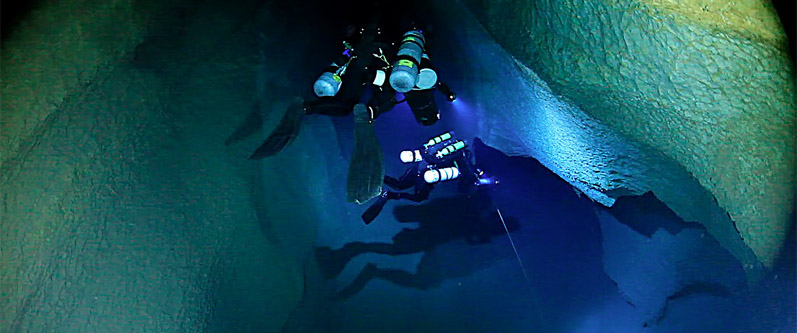 |
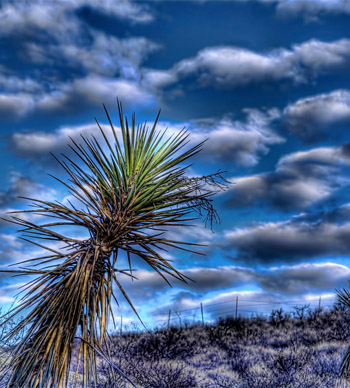 |
Above: The desserts of southwestern Texas stretch for hundreds of miles over rough terrain. Phantom Spring Cave is nestled within a small gorge and was once used as a water supply for local ranchers.
Below: The underwater passages of Phantom Spring vary from ten to sixty plus feet in diameter and seesaw up and down in depth from zero to 65 feet for the first 5400 feet of passage. |
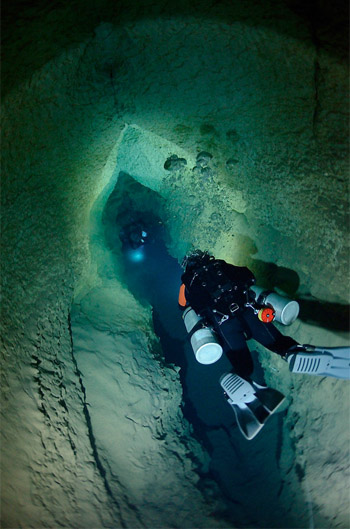 |
|
During the 17 months preceding our visit to Phantom Springs Cave, there had been no rain in the immediate area; the dust was nearly unbearable and the plant life almost none existent . How surprising it was that on our first day of diving, the area would see over an inch and a half of precipitation in the form of snow. Imagine our surprise when Curt, Dr. Iliffe and I exited the cave after a 2 hour dive only to be greeted with snow covering the ground. Our new friends in Toyahvale and Balmorhea said we brought the rain with us. We didn’t stop making rain there either.
The expedition started with the standard shake down dives. We never expected these shake downs to become shake ups but that is just what they did. The team pushed Phantom Springs Cave in more ways than one.
The first day Walter, Curt and Dr. Iliffe dove open circuit while staging safety bottles and managed to swim within a few hundred feet of the existing upstream end of line (EOL). This setup enabled Brett diving his KISS Classic rebreather and Andy diving his Prism rebreather to not only reach the upstream EOL but extend it 495ft (151m). The team of explorers described the room at the new EOL as being several hundred feet in diameter, a maximum depth of 135ft (41m) and blue water such that with the most advanced Light Monkey Enterprise’s HID lights, visibility was limitless.
Day 2 found the team confronted with the results of the much need snowfall – mud. The mud coupled with below freezing temperatures had now become something of an encumbrance not only on gear but personal as well. Regardless of the topside climate conditions, Brett and Andy set off into the amazing Phantom Springs Cave in hopes of emptying a reel containing almost 7,000ft (2,134m) of knotted line beyond the new upstream EOL. Planning for a 5-6 hour dive, the support team was a bit concerned when Andy and Brett surfaced after just less than 4 hours. While interviewing the exploration team, Brett said “Well it looks like we brought a little Florida with us”. Phantom Springs Cave was going deep and going deep in a hurry. Brett and Andy stopped their upstream exploration at a maximum depth of 237ft (72m) after adding another 440ft (134m) of explored upstream passage to the cave’s survey. Although the ADM Exploration Team is no stranger to deep cave diving, we lacked one critical ingredient – helium. We originally calculated our diluents and safety bottles to include minor helium percentages as this aids in the buoyancy characteristics of safety bottles. Upon the revelation that we were basically shutdown on day 2, the team discussed driving around the desert towns of west Texas in an attempt to find helium. We had brought with us a standalone Haskel boosting station, but we decided it was best to stick to the plan and focus on science and capturing the amazing beauty of Phantom Springs Cave with photographs and video.
Along with exploration, collecting specimens, shooting video, doing interviews and taking photographs, we saved a little time for radio location. Andy and Brett have made amazing improvements to the original radio location transmitters designed by Brian Pease. The new units are self-leveling and provide electronics that allow users to schedule when the unit should transmit (only on certain days, only between certain time periods, etc.). Aside from the new transmitters, the reception of the signal transmitted in the cave is currently still performed using one of Brian’s trusted “disc” receivers.
|
|
|
 |
Radio location is not only an important part of cave survey verification but in this case, it allowed us to pin point surface features that correlated with specimen collection locations. These locations were root balls where we tethered the transmitter to sit just below the surface of the water. Unfortunately, we were unable to find a “smoking gun” plant whose roots had dug, roamed and meandered more than 100 feet beneath the surface to bathe in the crystal waters of the cave below.
After all of our main objectives upstream were completed, Andy decided that he would brave the downstream portion of the cave. He was diving into flow that rivaled the discharge of Weeki Wachee Springs in Florida, but this passage was siphoning – an altogether different risk. Andy explored and surveyed 463ft (141m) of new passage in the downstream section of the cave. His descriptions of all but having to stand up while doing survey do little to accurately describe just how hard this cave wants to take you for a ride.
Once the statistics had been compiled, 37 cave dives lasting over 75 hours were conducted in the Phantom Springs Cave during a 5 day period. All of these dives were conducted within safe cave diving standards as defined by NSS-CDS & NACD. New exploration and mapping of upstream cave passage extended the known exploration by 935 feet (285m) and maximum depth was increased from 68ft (21m) to 237ft (72m). The upstream cave passage trends in a south southwest (SSW) direction and is increasing in size and depth with no end in sight. The new exploration of the downstream cave passage extended the known exploration by 463ft (141m) with no change in depth. The downstream cave passage trends in a southerly direction also with no end in sight, but this section of the cave is significantly smaller in size and with much higher velocity water currents.
|
|
Above: Explorer Brett Hemphill, discovers a Diamond Back Rattlesnake in a small dry cave just a few hundred feet from the Phantom cave entrance.
Below: Deep underground the cave radio transmitter provides a low frequency signal through solid rock. Andy Pitkin and Walter Pickel roam patterns across the desert carrying the cave radio locator, able to pinpoint the caves exact location within a meter. |
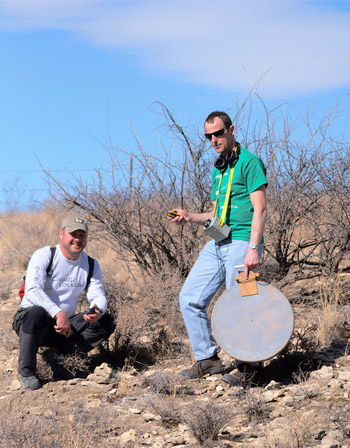 |
|
|
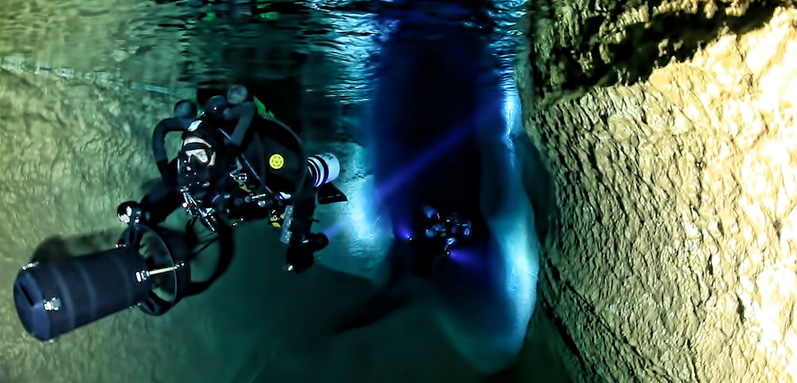 |
Above: Explorer Brett Hemphill , followed by Curt Bowen illuminate the furthest reaches of Phantom Spring for videographer Andy Pitkin.
Below: Beyon 7000 feet from the entrance the team discovers the "PIT". From this point the cave drops quickly, beyond 250 feet in depth. |
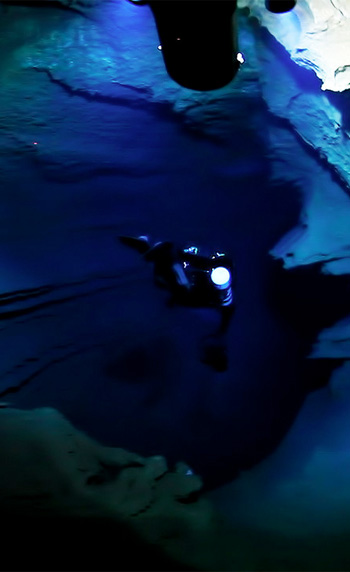 |
|
The scientific mission of this expedition was very successful in that 3 individuals of the isopod Cirolanides texensis were collected from the cave floor within the upstream cave passage. Also, visual surveys were conducted of root balls for presence of another isopod, Lirceolus cocytus. The team found that populations are located only on the two root balls in the upstream breakdown room, as originally observed on previous surveys by Sepp and Bill Tucker. However, two similar root balls in the downstream portion of the cave did not appear to have any visible invertebrates. Lastly, terrestrial cave adapted invertebrates (possibly a silverfish and spiders) were observed but not collected from the upper portion of the root ball in the upstream cave.
The Texas Speleological Society lists Phantom Springs Cave as the 19th longest and 65th deepest in Texas at 8,445ft (2,475m) with a maximum depth of 79ft (24m). During this expedition, explorers Brett and Andy, supported by the entire team, pushed the cave to 9,845ft (3000m) and to a new maximum depth of 237ft (72m). These numbers unofficially catapult Phantom Springs Cave to the 14th deepest and 17th longest cave in Texas, while also making it the longest underwater cave in the United States, outside of Florida.
The team would like to extend their most sincere appreciation to the Bureau of Reclamation for preserving such a unique cave and protecting the fauna that depends on the spring for its existence, the Eleven Inn for great and comfortable accommodations, Funky Li'l Diveshop for working with our odd schedule and making sure our tanks were always filled, Bill and Franci Tucker for sharing with us their own stories of exploration and the history, Texas A&M University for their tireless efforts in securing a permit for research and sponsoring the expedition. Funding for this trip was provided by a Texas A&M University and Consejo Nacional de Ciencia y Technologia (CONACYT) Collaborative Research Grant to T. Iliffe and F. Alvarez.
|
|
|
| |
|
| |
Left to Right:
Walter Pickel, Curt Bowen, Tom Iliffe,
Andy Pitkin, Brett Hemphill (back),
Sepp Haukebo, Bori Suranyi,
David Brankovits
|
|
|
|